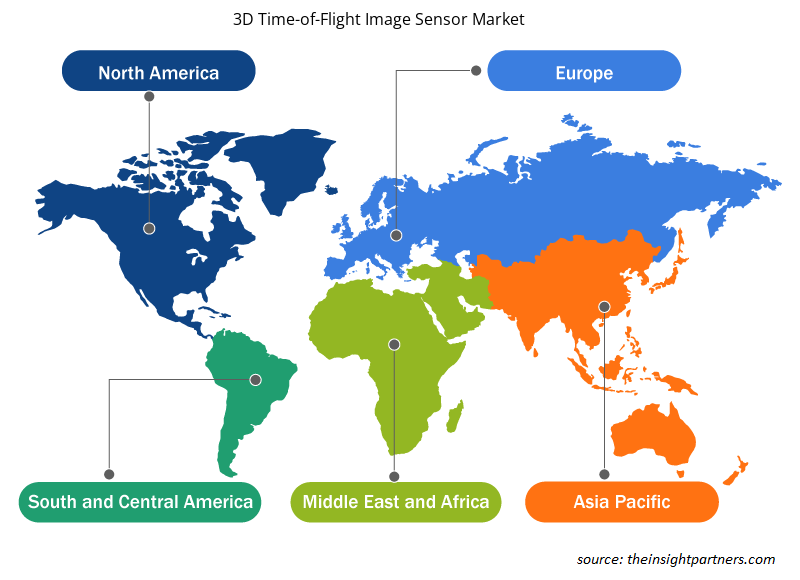3D 飛行時間型画像センサーの市場規模は、2023 年の 9,990 万米ドルから 2031 年には 1 億 6,780 万米ドルに達すると予測されています。市場は 2023 年から 2031 年にかけて 6.70% の CAGR を記録すると予想されています。消費者向け電子機器の需要の高まりと、ロボット アプリケーションにおける柔軟性とカスタマイズは、今後も世界の 3D 飛行時間型画像センサー市場の主要なトレンドであり続けると思われます。
世界の 3D 飛行時間型イメージセンサー市場分析
内部検知用に設計された TOF システムは、通常、単一の VCSEL を使用して 1 メートルの範囲内で 1% (1 cm に相当) の距離精度を提供します。ロボット アプリケーションで飛行時間 (TOF) センサーを使用すると、さまざまな利点があります。これらのセンサーは通常、画像分析によって処理された 2D カメラ ビデオ ストリームと比較して、より正確な深度測定を提供します。さらに、TOF カメラは可動部品がなく、フォーム ファクターがコンパクトで、コスト効率に優れた製造方法で知られています。リアルタイム アプリケーションに特に価値があり、最大 60 フレーム/秒の速度で非常に正確な深度データを提供します。
世界の 3D 飛行時間型イメージセンサー市場の概要
3D 飛行時間 (TOF) 画像センサー技術は、マシン ビジョン業界における革命的な進歩です。低コストの CMOS ピクセル アレイとアクティブ変調光源を組み合わせることで、この技術は 3D イメージングを可能にします。この技術は、光パルスが媒体を通過するのにかかる時間を測定することで機能します。この画期的なイノベーションにより、物理世界の真の 3D 深度マップをリアルタイムで取得できます。この技術は、撮影した画像内のシーン、周囲、およびすべてのオブジェクトをデジタル空間に効果的に変換します。その後、センサーに組み込まれたアルゴリズムを使用して、任意のオブジェクトと光源の相対距離とオブジェクトの寸法を測定します。
要件に合わせてレポートをカスタマイズする
このレポートの一部、国レベルの分析、Excelデータパックなど、あらゆるレポートを無料でカスタマイズできます。また、スタートアップや大学向けのお得なオファーや割引もご利用いただけます。
- このレポートの主要な市場動向を入手してください。この無料サンプルには、市場動向から見積もりや予測に至るまでのデータ分析が含まれます。
世界の 3D 飛行時間型イメージセンサー市場の推進要因と機会
自動車業界における消費者向け電子機器の融合の拡大と自律走行車への要求の高まり
自動車業界は、運転体験を向上させるために大きな変化を遂げてきました。今日の自動車は、よりスマートになり、自己診断が可能になり、道路上の他の存在との通信がより高度になっています。先進運転支援システム (ADAS)、インフォテインメント システム、カー テレマティクスなどのトレンドが自動車業界で注目を集めています。これらの進歩は、主に半導体業界の高度化と技術進歩によるものです。さらに、安全機能の実装により、過去 10 年間で自動車事故と死亡者数が減少しました。電子統合の増加により、自動車の計算能力が向上しました。カー テレマティクスやユーザー フレンドリーなインフォテインメント システムなどのトレンドの出現は、ドライバーと乗客の安全に重点を置いて開発されています。これらのシステムにより、障害物の検出、ナビゲーション、車内のインフォテインメント システムの操作性の向上も可能になります。さらに、自動車アプリケーションに 3D ToF センサーを統合することで、運転中に音楽やラジオのチャンネルを変更するなどのタスクを簡単なハンドスワイプ ジェスチャーで実行できるなど、インフォテインメント システムの高度でユーザー フレンドリーで便利な操作が可能になります。これらの進歩の結果、自動車市場における 3D 飛行時間センサーの需要は予測期間中に増加すると予測されています。
生体認証とセキュリティの技術開発
生体認証とセキュリティの技術の急速な進歩は、近い将来、3D 飛行時間型画像センサーの必要性に大きな影響を与えると予想されています。この進歩は、生体認証技術の進歩、一般の受容の高まり、高度なセキュリティ対策の需要の高まりなど、さまざまな要因の影響を受けています。生体認証とセキュリティの急速な技術進歩は、生体認証技術の進歩によって推進されており、生体認証システムの採用を加速させています。たとえば、新しいシステムでは、3D 画像を偽造の平面画像と区別するために人工知能分析を統合しており、生体認証セキュリティの制限に対処し、採用の障壁を軽減しています。生体認証技術は、測定可能な生物学的特徴を利用してデジタルユーザーの ID を検証し、指紋認証、顔認識、虹彩認識、DNA 検査を網羅しています。人工知能は、生体認証ツールでキャプチャされたデータを分析し、その真正性を確認するために一般的に使用されています。
グローバル 3D 飛行時間型イメージセンサー市場レポートのセグメンテーション分析
世界的な 3D 飛行時間型イメージセンサー市場分析の導出に貢献した主要なセグメントは、タイプとアプリケーションです。
- タイプに基づいて、市場はハーフQQVGA ToFイメージセンサー、QVGA ToFイメージセンサー、VGA ToFイメージセンサー、および1 MP ToFイメージセンサーに分類されます。QVGA ToFイメージセンサーセグメントは、2023年に大きな市場シェアを占めました。
- アプリケーション別に見ると、市場は民生用電子機器、自動車、エンターテインメント、マシンビジョンと産業オートメーション、ロボット工学とドローン、その他に分類されています。民生用電子機器セグメントは、2023年に市場で大きなシェアを占めました。
地域別 3D 飛行時間型イメージセンサーの世界市場シェア分析
世界の 3D 飛行時間型イメージセンサー市場レポートの地理的範囲は、主に北米、アジア太平洋、ヨーロッパ、中東およびアフリカ、南米/中南米の 5 つの地域に分かれています。
ヨーロッパの 3D 飛行時間型画像センサー市場は、さまざまなアプリケーションと技術の進歩により、大幅な成長を遂げています。ヨーロッパ地域は、3D 飛行時間型画像センサーの世界市場で重要な役割を担っています。自動車、民生用電子機器、産業オートメーション、マシン ビジョン技術、エンターテイメントなどの業界でこれらのセンサーの需要が高まっていることが、ヨーロッパの市場成長の大きな原動力となっています。
グローバル
3D 飛行時間型イメージセンサー市場の地域別分析
予測期間を通じて 3D 飛行時間型画像センサー市場に影響を与える地域的な傾向と要因は、Insight Partners のアナリストによって徹底的に説明されています。このセクションでは、北米、ヨーロッパ、アジア太平洋、中東およびアフリカ、南米および中米にわたる 3D 飛行時間型画像センサー市場のセグメントと地域についても説明します。

- 3D飛行時間型画像センサー市場の地域別データを入手
3Dタイムオブフライトイメージセンサー市場レポートの範囲
| レポート属性 | 詳細 |
|---|---|
| 2023年の市場規模 | 9,990万米ドル |
| 2031年までの市場規模 | 1億6,780万米ドル |
| 世界のCAGR(2023年~2031年) | 6.7% |
| 履歴データ | 2021-2022 |
| 予測期間 | 2024-2031 |
| 対象セグメント | タイプ別
|
| 対象地域と国 | 北米
|
| 市場リーダーと主要企業プロフィール |
|
3D 飛行時間型イメージセンサー市場のプレーヤー密度: ビジネスダイナミクスへの影響を理解する
3D 飛行時間型イメージセンサー市場は、消費者の嗜好の変化、技術の進歩、製品の利点に対する認識の高まりなどの要因により、エンドユーザーの需要が高まり、急速に成長しています。需要が高まるにつれて、企業は提供を拡大し、消費者のニーズを満たすために革新し、新たなトレンドを活用し、市場の成長をさらに促進しています。
市場プレーヤー密度とは、特定の市場または業界内で活動している企業または会社の分布を指します。これは、特定の市場スペースに、その市場規模または総市場価値に対してどれだけの競合相手 (市場プレーヤー) が存在するかを示します。
3D 飛行時間型イメージセンサー市場で事業を展開している主要企業は次のとおりです。
- アダフルーツ インダストリーズ
- アムスAG
- ifmエレクトロニック有限会社
- インフィニオンテクノロジーズAG
- キーエンス株式会社
- メレキシス
免責事項:上記の企業は、特定の順序でランク付けされていません。

- 3D飛行時間型イメージセンサー市場のトップキープレーヤーの概要を入手
世界の 3D 飛行時間型イメージセンサー市場のニュースと最近の動向
世界の 3D 飛行時間型イメージセンサー市場は、重要な企業出版物、協会データ、データベースを含む一次調査と二次調査後の定性的および定量的データを収集することによって評価されます。以下は、市場の動向の一覧です。
- STは、20億個のFlightSense™デバイスを販売し、ダイレクトToFセンサのリーダーとしての地位を築いた上で、カメラアシスト、バーチャルリアリティ、3Dウェブカメラ、ロボット工学、スマートビルディングなどの主要アプリケーション向けに、新しいダイレクトおよび間接ToFセンサを発表しました。最大2,300ゾーンに対応する市場初の真のオールインワンdToF LiDARモジュールは、スマートフォンのカメラアシストやAR/VRアプリケーションを対象としています。解像度672×804ピクセルの世界最小のiToFセンサは、Lanxin Technologyで初の設計受注を獲得し、現在量産中です。
(出典: STMicroelectronics、プレスリリース、2024年)
グローバル 3D 飛行時間型イメージセンサー市場レポートの対象範囲と成果物
「世界の3D飛行時間型イメージセンサー市場の規模と予測(2023〜2031年)」レポートでは、以下の分野をカバーする市場の詳細な分析を提供しています。
- 対象範囲に含まれるすべての主要市場セグメントの世界、地域、国レベルでの市場規模と予測
- 市場の動向(推進要因、制約、主要な機会など)
- 今後の主な動向
- 詳細なPEST/ポーターの5つの力とSWOT分析
- 主要な市場動向、主要プレーヤー、規制、最近の市場動向を網羅した世界および地域の市場分析
- 市場集中、ヒートマップ分析、主要プレーヤー、最近の動向を網羅した業界の状況と競争分析
- 詳細な企業プロフィール
- 過去2年間の分析、基準年、CAGRによる予測(7年間)
- PEST分析とSWOT分析
- 市場規模価値/数量 - 世界、地域、国
- 業界と競争環境
- Excel データセット
最新レポート
関連レポート
お客様の声
購入理由
- 情報に基づいた意思決定
- 市場動向の理解
- 競合分析
- 顧客インサイト
- 市場予測
- リスク軽減
- 戦略計画
- 投資の正当性
- 新興市場の特定
- マーケティング戦略の強化
- 業務効率の向上
- 規制動向への対応























 無料サンプルを入手 - 3D飛行時間型イメージセンサー市場
無料サンプルを入手 - 3D飛行時間型イメージセンサー市場